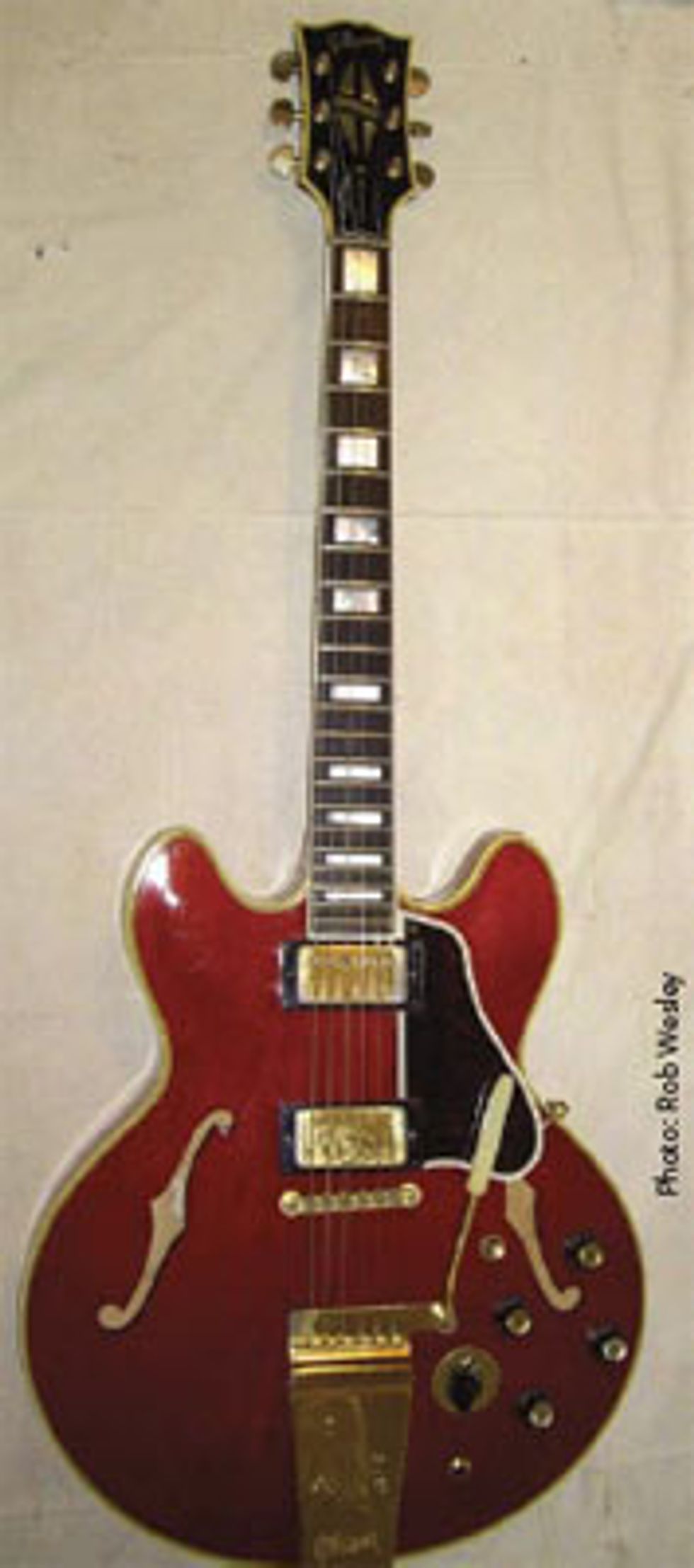--> A Gibson ES-355 TDC Since last month’s installment I’ve been watching YouTube in a quest for some insightful angles (and some not-so-obvious answers) as to what really makes
 | |
|
Part of this theory began in the early seventies when Alembic claimed that installing solid brass nuts and other heavy brass hardware increased sustain due to the increased mass given to these areas of the instrument. While their claims were questionable, one thing was for sure – these instruments spawned a lot of shoulder problems due to the weight of fancy, exotic wood and beefed-up brass hardware.
There was also a particularly famous Gibson ES-335 player that touted the use of a stop tailpiece to give a guitar more sustain, but what I observed and heard (some 30-odd years later) was quite startling to say the least. Here’s where the craziness began for me. I stumbled upon a YouTube clip of the late, great Freddie King playing an ES-355 TDC. Interestingly enough, many great American bluesmen favor the ES-355 TDC; although B.B. King used an ES-335 early on, he eventually landed on his ever-present and famously named ES-355 TDC. In the mid to late-sixties in England there were two very influential guitarists using vintage dot-neck ES-335s – Alvin Lee of Ten Years After and Ritchie Blackmore of Deep Purple.
How does this all fit together, you ask? When you see footage of Freddie King playing his 355, you’ll notice that he played with his fingers; however, he actually yanked the strings up with his third and middle fingers while playing through a Fender Super-Six Reverb set at full-tilt. In the case of B.B. King, he also runs his amplifier (now a Lab Series L- 5 solid-state model) at very high volume, only B.B. controls the overall volume with his right hand to emphasize a stinger note while bringing it right back down to a whisper just a split second later. Both tones are vicious and snarling, but I noticed something that all of the above-mentioned players had in common. All of them had either Bigsby vibrato units (Lee and Blackmore’s ES-335s) or Maestro “Vibrola” units (on the ES-355 TDCs) that were factory-installed. However, you didn’t see them use the vibrato bar at all – in fact, they were turned backwards and remained stationary.
The point is that all of these players had stellar tone without stop tailpieces or brass hardware. Outside of their guitar choice, it’s all flesh, personal technique and volume that really contributed to their unique sound. However, I should mention that the weight of the Bigsby/Maestro Vibrola accomplishes another task; it gives the instrument more string-to-string separation and has a different effect on the overtone series. Does this mean that Eric Clapton’s 1964 stop tailpiece ES-335 sucked? No way folks, it’s just a different tone.
Bear in mind that the Maestro Vibrola units were stock on guitars such as the SG Special (Standards and Customs) as well as Firebird VIIs and ES-355 TDCs. Earlier models of ES- 335 and ES-345 used Bigsbys. No matter, as the same sonic principal applies here.
Since we used Eric Clapton as an earlier example, we would be remiss if we didn’t mention that his famously painted “The Fool” SG Standard had its Vibrola bar removed – however, the long, metallic Maestro assembly that was part of the main unit actually stayed on the guitar. Eric probably elected to remove the vibrato arm because he didn’t use it. My feeling is that these players bought the guitars they used only because they sounded great to their ears and not because of their stock (or perhaps modified) parts.
I also strongly believe that what players wanted back in the early 1970s was more gain from their amplifiers, not sustain per se. Listening to Freddie King will convince you that he more than accomplished his goal by using his stock Gibson ES-355 TDC with a Fender Super-Six pushed way past the point of stability. You can also watch his hands and see that he avoided the low E string because if it accidentally rang out it would have sounded flabby and lacking in definition, due to the amp being pumped at fullblast. Yet the higher five strings still sounded like a raging pitbull to me – I loved the way Freddie got his tone by yanking the strings with two fingers. PAFs or not, Freddie King affected us with every single thing he did. We’ll see you next month.
Richie Blackmore''s Concerto Solo
Freddie King''s Blues Band Shuffle:
Freddie King''s Have You Ever Loved a Woman:
Freddie King''s Goin'' Down:
Dean Farley
Dean Farley is the chief designer of "Snake Oil Brand Strings" (www.sobstrings.net) and has had a profound influence on the trends in the strings of today

